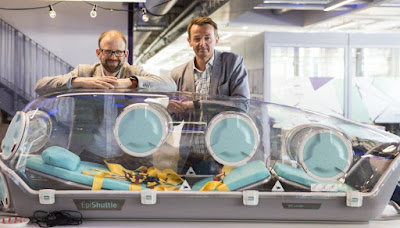Bodily Injury or Other Health Issue
Bodily injury occurring outside a habitat or environmental vehicle can quickly turn deadly so quick action is required.
A suit tear resulting from an accident inflicting a bodily injury compounds the accident by putting the air supply in jeopardy. The issues of treating a persons injuries while encased inside an environmental suit prevents most first aid treatments, and, distance from the habitat requires some form of “ambulance” to return the injured person to safety.
So, we are looking at a means of emergency life support that addresses air, aid and transport all in one easy to use device.
1. A typical stretcher usually requires 2 people to carry the injured but it does not address air or aid, only transport.
2. Providing emergency air and a suit patch alleviates the punctured suit scenario but not the transport or aid issue.
3. Patching a suit, applying a splint (for broken leg etc) covers some aid issues, the air issues, but not transportation to safety. Depending upon the weight and bulkiness of a standard colonial suit the ability to carry someone may not be an option.
The alternative to all three issues is a portable “ambulance” that can be made air tight yet small enough and lightweight enough so one person can easily manage another. Such a vehicle would need to be light, strong, and easily portable and also contain an emergency life support system for air, heat, scrubbing, and potentially electrical as well.
Such a device already exists and would require very few
modifications.[1]. The
EpiShuttle is a portable, environmentally sealed stretcher from
Figure 11 Norwegian designed "Epi-Shuttle
Figure 12 Inflatable Emergency Life Support Sledge
One concern with such a vehicle would be the pressure differentials between planetary atmosphere and suit pressure if the intent is to open a colonist’s suit to render first aid in the field. This is where a hard shell may be more useful than a soft shell.
Walking about on the moon the astronauts seemed to trip and fall or otherwise simply loses their balance quite frequently based on available videos. Suit tears and helmet face plates being cracked by a sharp rock were potential issues. Imagine the higher potential for similar accidents happening if colonists were working outside much more frequently and for longer periods.
When actually doing construction in a colonial environment the potential increases as industrial accidents occur much more frequently than we would like. According to the United State Department of Labor About 20% (1,061) of worker fatalities in private industry in calendar year 2019 were in construction[2]
Figure 13 Portable Excursion Habitat
Sjaak Lucassen is
going to ride this modified 2001 Yamaha YZF-R1 from



Comments
Post a Comment